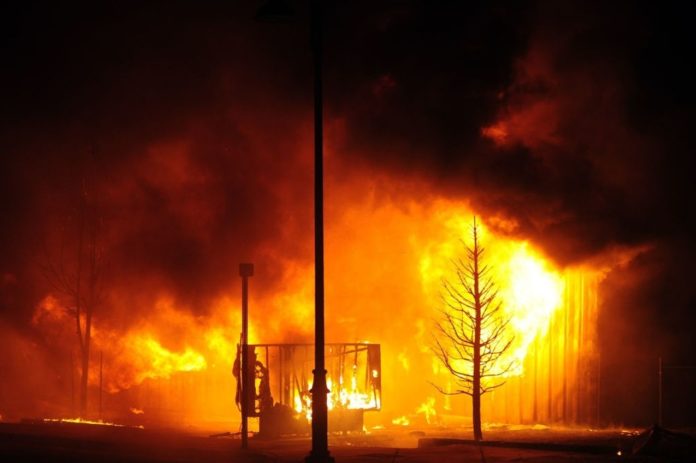Thousands of COVID-19 cases and deaths between March and December 2020 in California, Oregon, and Washington could be attributed to increases in fine particulate air pollution (PM2.5) caused by wildfire smoke, according to a new study co-authored by researchers at Harvard T.H. Chan School of Public Health.
The study is the first to quantify the extent to which wildfire-related increases in PM2.5 pollution contributed to an increase in COVID-19 cases and deaths in the United States.
- Scientists in Fear of This New Predator From Red Sea Eating Native Species in Mediterranean
- Does This Mean We Stopped Being Animal and Started Being Human Due to ‘Copy Paste’ Errors?
- The One Lifestyle Choice That Could Reduce Your Heart Disease Risk By More Than 22%
- Aging: This Is What Happens Inside Your Body Right After Exercise
- Immune-Boosting Drink that Mimics Fasting to Reduce Fat – Scientists ‘Were Surprised’ By New Findings
It was published online in Science Advances on August 13, 2021.
In 2020, as the country battled the COVID-19 pandemic, massive wildfires swept across the western United States, including some of the largest in history in California and Washington.
Wildfires generate high concentrations of fine particulate matter (PM2.5), which has been linked to a variety of adverse health outcomes, including premature death, asthma, chronic obstructive pulmonary disease (COPD), and other respiratory illnesses.
Additionally, recent studies have established a link between acute and chronic exposure to PM2.5 and COVID-19 cases and deaths.
The researchers, from Harvard Chan School, Harvard University’s John A. Paulson School of Engineering and Applied Sciences, and the Environmental Systems Research Institute in Redlands, California, developed and validated a statistical model to determine the extent to which wildfire smoke may have contributed to an increase in COVID-19 cases and deaths in California, Oregon, and Washington.
They investigated the relationship between county- and daily-level data on PM2.5 air concentrations from monitoring data, wildfire days from satellite data, and the number of COVID-19 cases and deaths in 92 counties that represented 95 percent of the population in the three states.
Weather, population size, and societal patterns of social distancing and mass gatherings were all taken into account by the researchers.
The study discovered that between August 15 and October 15, 2020, when fire activity was at its peak, daily PM2.5 levels were significantly higher on wildfire days than on non-wildfire days, averaging 31.2 micrograms per cubic metre of air (g/m3) versus 6.4 (g/m3). On wildfire days, PM2.5 levels reached dangerously high levels in some counties. For example, from September 14 to September 17, 2020, Mono County, Calif., experienced four consecutive days with PM2.5 concentrations greater than 500 g/m3, owing to the Creek Fire. The US Environmental Protection Agency classifies such levels as “hazardous.”
The study discovered that wildfires amplified the effect of PM2.5 exposure on COVID-19 cases and deaths up to four weeks after exposure. In some counties, a sizable proportion of COVID-19 cases and deaths were attributed to elevated PM2.5 levels.
The study discovered that an increase in PM2.5 of 10 g/m3 per day for 28 consecutive days was associated with an 11.7 percent increase in COVID-19 cases and an 8.4 percent increase in COVID-19 deaths on average across all counties. The counties of Sonoma, Calif., and Whitman, Wash., saw the greatest increase in COVID-19 cases, increasing by 65.3 percent and 71.6 percent, respectively. Calaveras and San Bernardino counties in California saw the greatest increase in COVID-19 deaths, increasing by 52.8 percent and 65.9 percent, respectively.
When the researchers examined individual wildfire days and counties, they discovered that Butte, Calif. and Whitman, Wash. had the highest percentages of total COVID-19 cases attributable to elevated PM2.5 levels during the wildfires: 17.3 percent and 18.2 percent, respectively, of the total COVID-19 cases in these counties were attributable to elevated PM2.5 levels. Butte and Calaveras counties in California had the highest percentages of total COVID-19 deaths attributable to elevated PM2.5 levels during the wildfires: 41 percent and 137.4 percent, respectively, of total COVID-19 deaths in these counties were directly attributable to elevated PM2.5 levels.
- Scientists in Fear of This New Predator From Red Sea Eating Native Species in Mediterranean
- Does This Mean We Stopped Being Animal and Started Being Human Due to ‘Copy Paste’ Errors?
- The One Lifestyle Choice That Could Reduce Your Heart Disease Risk By More Than 22%
- Aging: This Is What Happens Inside Your Body Right After Exercise
- Immune-Boosting Drink that Mimics Fasting to Reduce Fat – Scientists ‘Were Surprised’ By New Findings
The study found that the cumulative number of COVID-19 cases and deaths attributable to daily increases in PM2.5 caused by wildfires was 19,700 and 750, respectively, across the three states studied.
Photo by Neal Waters/Anadolu Agency via Getty Images
